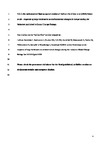Adapt or die—Response of large herbivores to environmental changes in Europe during the Holocene
| dc.contributor.author | Hofman‐Kamińska, E | |
| dc.contributor.author | Bocherens, H | |
| dc.contributor.author | Drucker, DG | |
| dc.contributor.author | Fyfe, R | |
| dc.contributor.author | Gumiński, W | |
| dc.contributor.author | Makowiecki, D | |
| dc.contributor.author | Pacher, M | |
| dc.contributor.author | Piličiauskienė, G | |
| dc.contributor.author | Samojlik, T | |
| dc.contributor.author | Woodbridge, Jessie | |
| dc.contributor.author | Kowalczyk, R | |
| dc.date.accessioned | 2019-07-15T09:09:21Z | |
| dc.date.issued | 2019-09 | |
| dc.identifier.issn | 1354-1013 | |
| dc.identifier.issn | 1365-2486 | |
| dc.identifier.other | 0 | |
| dc.identifier.uri | http://hdl.handle.net/10026.1/14643 | |
| dc.description.abstract |
<jats:title>Abstract</jats:title><jats:p>Climate warming and human landscape transformation during the Holocene resulted in environmental changes for wild animals. The last remnants of the European Pleistocene megafauna that survived into the Holocene were particularly vulnerable to changes in habitat. To track the response of habitat use and foraging of large herbivores to natural and anthropogenic changes in environmental conditions during the Holocene, we investigated carbon (<jats:italic>δ</jats:italic><jats:sup>13</jats:sup>C) and nitrogen (<jats:italic>δ</jats:italic><jats:sup>15</jats:sup>N) stable isotope composition in bone collagen of moose (<jats:italic>Alces alces</jats:italic>), European bison (<jats:italic>Bison bonasus</jats:italic>) and aurochs (<jats:italic>Bos primigenius</jats:italic>) in Central and Eastern Europe. We found strong variations in isotope compositions in the studied species throughout the Holocene and diverse responses to changing environmental conditions. All three species showed significant changes in their <jats:italic>δ</jats:italic><jats:sup>13</jats:sup>C values reflecting a shift of foraging habitats from more open in the Early and pre‐Neolithic Holocene to more forest during the Neolithic and Late Holocene. This shift was strongest in European bison, suggesting higher plasticity, more limited in moose, and the least in aurochs. Significant increases of <jats:italic>δ</jats:italic><jats:sup>15</jats:sup>N values in European bison and moose are evidence of a diet change towards more grazing, but may also reflect increased nitrogen in soils following deglaciation and global temperature increases. Among the factors explaining the observed isotope variations were time (age of samples), longitude and elevation in European bison, and time, longitude and forest cover in aurochs. None of the analysed factors explained isotope variations in moose. Our results demonstrate the strong influence of natural (forest expansion) and anthropogenic (deforestation and human pressure) changes on the foraging ecology of large herbivores, with forests playing a major role as a refugial habitat since the Neolithic, particularly for European bison and aurochs. We propose that high flexibility in foraging strategy was the key for survival of large herbivores in the changing environmental conditions of the Holocene.</jats:p> | |
| dc.format.extent | 2915-2930 | |
| dc.format.medium | Print-Electronic | |
| dc.language | en | |
| dc.language.iso | en | |
| dc.publisher | Wiley | |
| dc.subject | Alces alces | |
| dc.subject | aurochs | |
| dc.subject | Bison bonasus | |
| dc.subject | Bos primigenius | |
| dc.subject | European bison | |
| dc.subject | foraging ecology | |
| dc.subject | moose | |
| dc.subject | stable isotopes | |
| dc.title | Adapt or die—Response of large herbivores to environmental changes in Europe during the Holocene | |
| dc.type | journal-article | |
| dc.type | Journal Article | |
| dc.type | Research Support, Non-U.S. Gov't | |
| plymouth.author-url | https://www.webofscience.com/api/gateway?GWVersion=2&SrcApp=PARTNER_APP&SrcAuth=LinksAMR&KeyUT=WOS:000475138300001&DestLinkType=FullRecord&DestApp=ALL_WOS&UsrCustomerID=11bb513d99f797142bcfeffcc58ea008 | |
| plymouth.issue | 9 | |
| plymouth.volume | 25 | |
| plymouth.publication-status | Published | |
| plymouth.journal | Global Change Biology | |
| dc.identifier.doi | 10.1111/gcb.14733 | |
| plymouth.organisational-group | /Plymouth | |
| plymouth.organisational-group | /Plymouth/Admin Group - REF | |
| plymouth.organisational-group | /Plymouth/Admin Group - REF/REF Admin Group - FoSE | |
| plymouth.organisational-group | /Plymouth/Faculty of Science and Engineering | |
| plymouth.organisational-group | /Plymouth/Faculty of Science and Engineering/School of Geography, Earth and Environmental Sciences | |
| plymouth.organisational-group | /Plymouth/REF 2021 Researchers by UoA | |
| plymouth.organisational-group | /Plymouth/REF 2021 Researchers by UoA/UoA14 Geography and Environmental Studies | |
| plymouth.organisational-group | /Plymouth/Research Groups | |
| plymouth.organisational-group | /Plymouth/Research Groups/Centre for Research in Environment and Society (CeRES) | |
| plymouth.organisational-group | /Plymouth/Research Groups/Centre for Research in Environment and Society (CeRES)/CeRES (Reporting) | |
| plymouth.organisational-group | /Plymouth/Research Groups/Marine Institute | |
| plymouth.organisational-group | /Plymouth/Users by role | |
| plymouth.organisational-group | /Plymouth/Users by role/Academics | |
| dc.publisher.place | England | |
| dcterms.dateAccepted | 2019-05-19 | |
| dc.rights.embargodate | 2020-7-11 | |
| dc.identifier.eissn | 1365-2486 | |
| dc.rights.embargoperiod | Not known | |
| rioxxterms.versionofrecord | 10.1111/gcb.14733 | |
| rioxxterms.licenseref.uri | http://www.rioxx.net/licenses/all-rights-reserved | |
| rioxxterms.type | Journal Article/Review |


